The Crucial MX300 750GB SSD Review: Micron's 3D NAND Arrives
by Billy Tallis on June 14, 2016 9:00 AM ESTMixed Random Read/Write Performance
The mixed random I/O benchmark starts with a pure read test and gradually increases the proportion of writes, finishing with pure writes. The queue depth is 3 for the entire test and each subtest lasts for 3 minutes, for a total test duration of 18 minutes. As with the pure random write test, this test is restricted to a 16GB span of the drive, which is empty save for the 16GB test file.
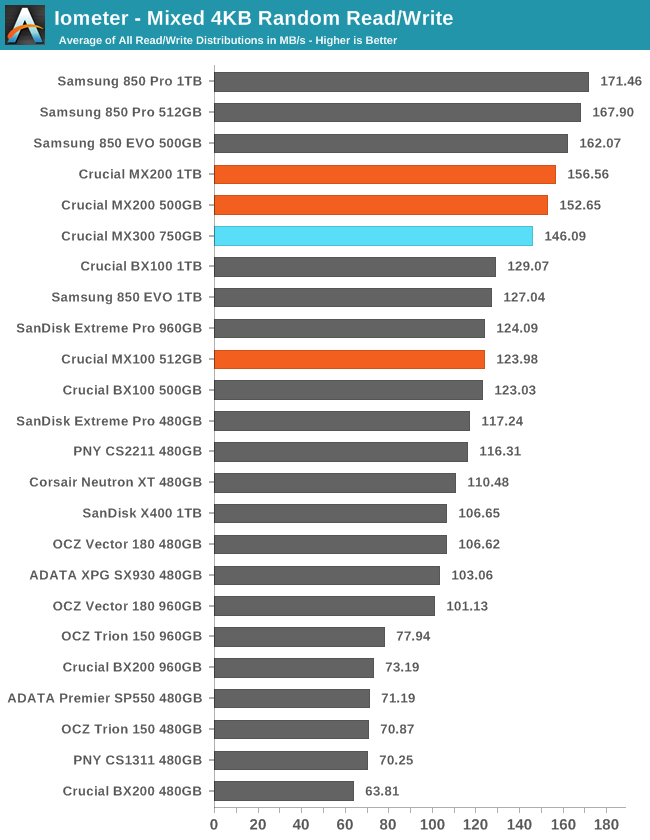
Despite poor random read speeds, the MX300 is only slightly slower than the MX200 on mixed random workloads, and is faster than most MLC drives.
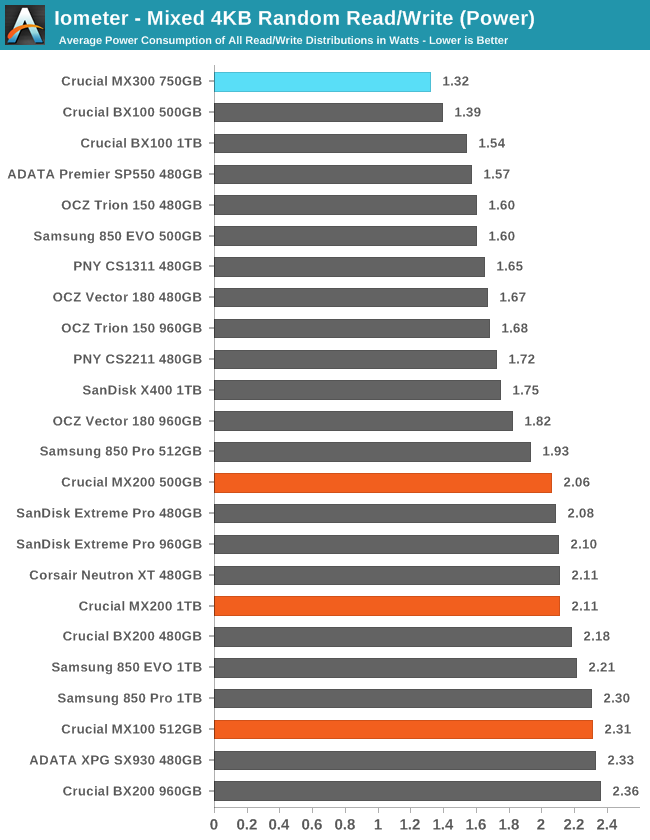
Once more setting a power usage record, the MX300 is more efficient than even the BX100.
 |
|||||||||
The MX300 manages to never decrease in performance when the proportion or writes increases, showing that its SLC write caching is working very effectively. Power consumption doesn't begin to increase until the test is almost completely writes.
Mixed Sequential Read/Write Performance
The mixed sequential access test covers the entire span of the drive and uses a queue depth of one. It starts with a pure read test and gradually increases the proportion of writes, finishing with pure writes. Each subtest lasts for 3 minutes, for a total test duration of 18 minutes. The drive is filled before the test starts.
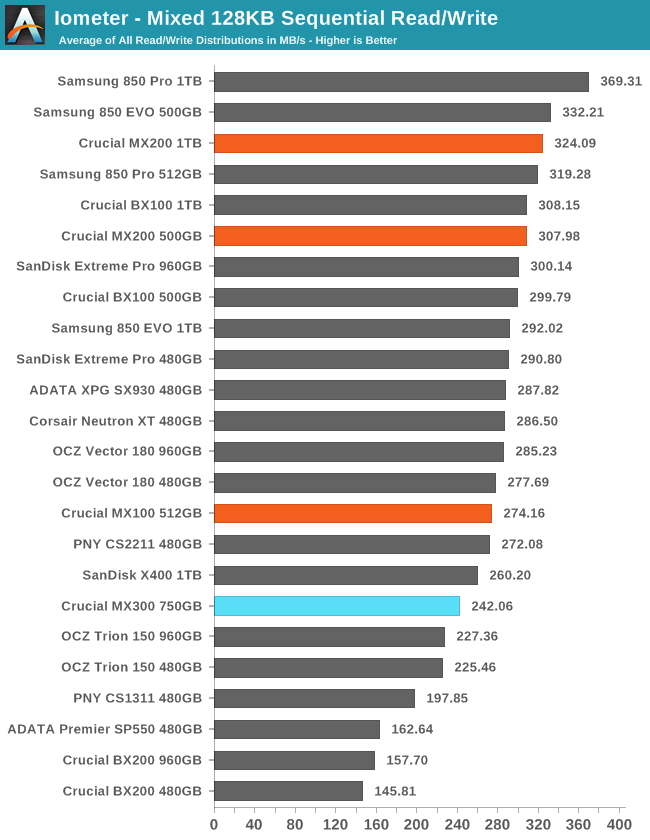
Since SATA drives all perform about the same on sequential reads, rankings on this test are determined mainly by sequential write performance and whether the controller can process the mixed workload effectively. The MX300 is slower than the SanDisk X400 but faster than the other planar TLC drives.
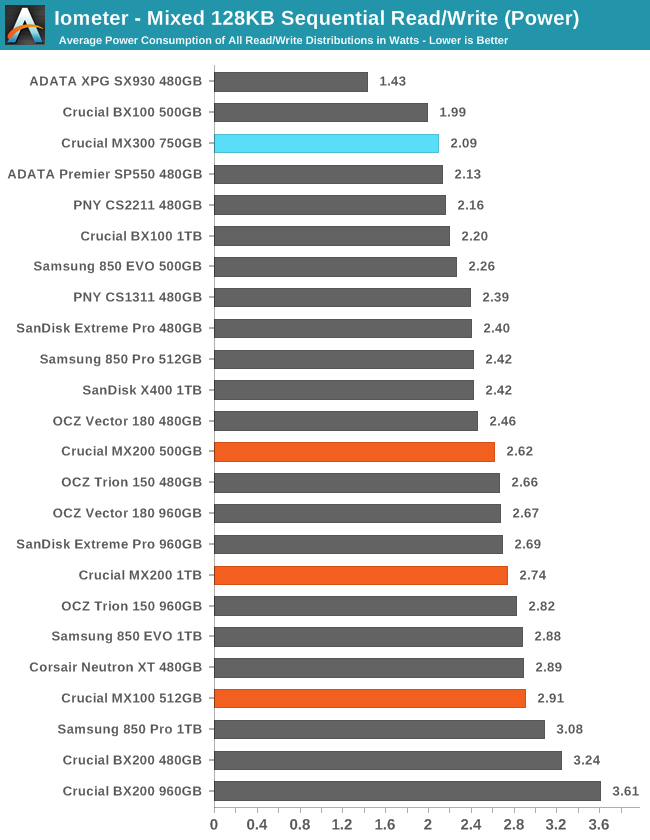
With another third place ranking for power usage, the MX300 beats all the planar TLC drives on efficiency but is unremarkable by MLC standards.
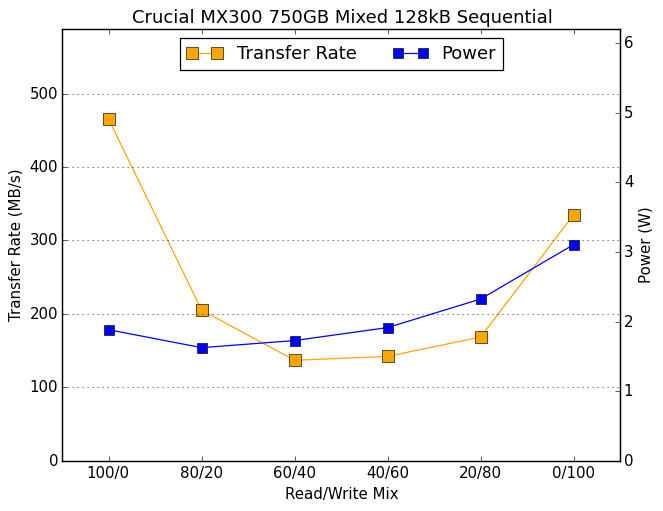 |
|||||||||
The MX300 bottoms out around 126MB/s which would be respectable for a planar TLC drive, but the MX200 never drops below 200MB/s.










85 Comments
View All Comments
Impulses - Wednesday, June 15, 2016 - link
Most users are still served fine by lower cost SATA drives and they'll probably remain common for years to come... And nobody is using SATA Express, wouldn't be surprised if it disappears from mobos, stillborn interface.M.2/PCI-E vs SATA is almost like 7,200+ RPM vs 5,400 RPM at this point.
Adam-James - Thursday, June 16, 2016 - link
"And nobody is using SATA Express..."That's part of the problem. Why is this a state of affairs that we're OK with? To me, the fact that no manufacturer has yet released, or has future plans to release, a SATA Express drive is infuriating, and even more so when they continue to put out AHCI SATA drives. That every flash manufacturer is so satisfied with the status quo and uninterested in improving the technology they sell is outrageous. And they're following the same pattern with U.2 - I've read about at least one executive who had the gall to claim his company wasn't adopting it for their SSD line because consumers "aren't interested." The industry might be satisfied with mediocrity, but we shouldn't be.
Impulses - Friday, June 17, 2016 - link
I don't think it's about mediocrity on the manufacturer's party... It's just a mediocre interface. M.2/U.2 are far better suited for next gen drives, and if you don't need that kinda performance (and most people don't) then SATA is fine. SATA Express represents an awkward middle ground that would potentially bottleneck next gen PCI-E/M.2 drives, so it seems the industry just said "why bother?".KAlmquist - Wednesday, June 15, 2016 - link
1. Samsung's accomplishment with the 850 EVO looks even better today. I was expecting that the Intel/Micron product would be as good as the Samsung 3D NAND when it finally came to market. But it appears that the 1.5 year old Samsung 3D TLC NAND is faster than the 3D TLC NAND that Intel/Micron has just introduced.2. Fifteen months ago we were hearing claims that Intel/Micron 3D NAND would have "disruptive pricing." Currently, the 750GB MX300 sells for its list price of $200. Last October, hypothetical 750GB BX-100 SSD would have cost $232. (This price is computed by averaging the price of the 500GB and 1TB models.) That's a 14% price decrease over eight months, which is significant, but hardly "disruptive." Perhaps we will see some aggressive pricing in the future, once production ramps up, but for now "disruptive pricing" isn't happening.
We can hope that Toshiba/SanDisk 3D NAND (which should appear this year) will prove more exciting. There's also SK Hynix, which as far as I know is currently using its 3D NAND only in enterprise products.
Impulses - Wednesday, June 15, 2016 - link
Indeed.ST33LDI9ITAL - Friday, June 17, 2016 - link
Name other SSD's at this price point that also have power protection and full encryption/edrive support....ST33LDI9ITAL - Sunday, June 19, 2016 - link
Exactly... it's not all about performance... features matter too. This drive has good performance, good feature set, and good prices. It is an all around great mainstream drive.dananski - Friday, June 17, 2016 - link
Makes me so glad to have gotten a BX100 when they came out. Why can't they pull off something like that again? The budget drive that competed with Samsung on general performance and beat everything on power consumption.ZapNZs - Sunday, June 19, 2016 - link
Are the endurance specs correct? It seems unlikely the TLC in the MX300 will be anywhere near the MX200, even regardless of capacity differences.Billy Tallis - Tuesday, June 21, 2016 - link
Yes, the endurance specs are correct. I can't say for sure that the MX300 specs are equally conservative as the MX200 specs, but the whole point of 3D NAND is to enable a return to larger memory cells that are more like the ones from the early days of the SSD revolution, where even tiny drives had high endurance ratings because they had P/E cycle ratings that were five or six digits long instead of three or four. 3D NAND makes it possible to have big memory cells and still have a lot of them on one chip.